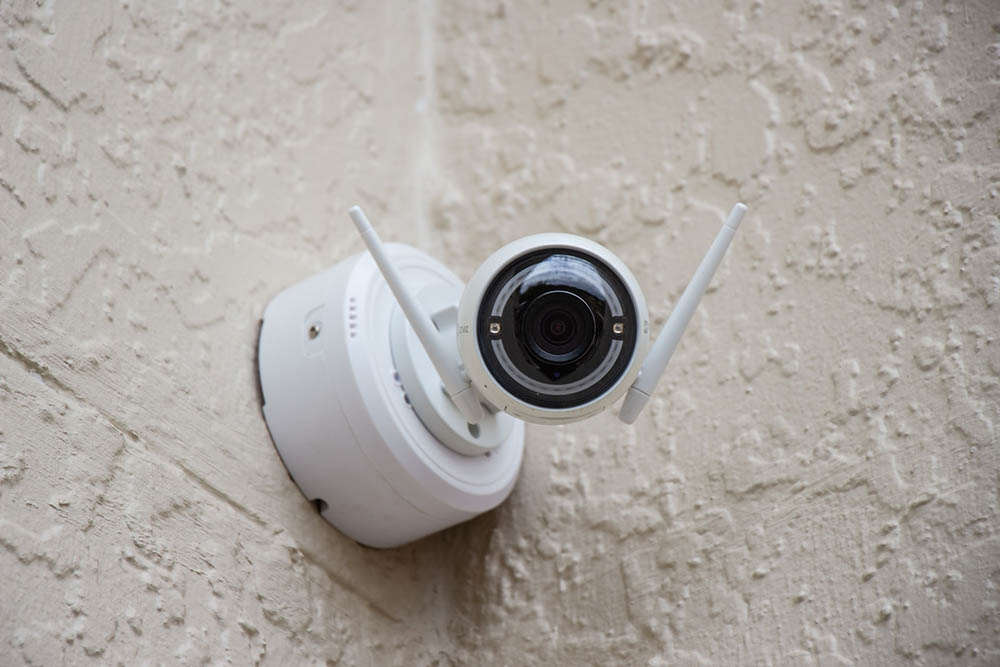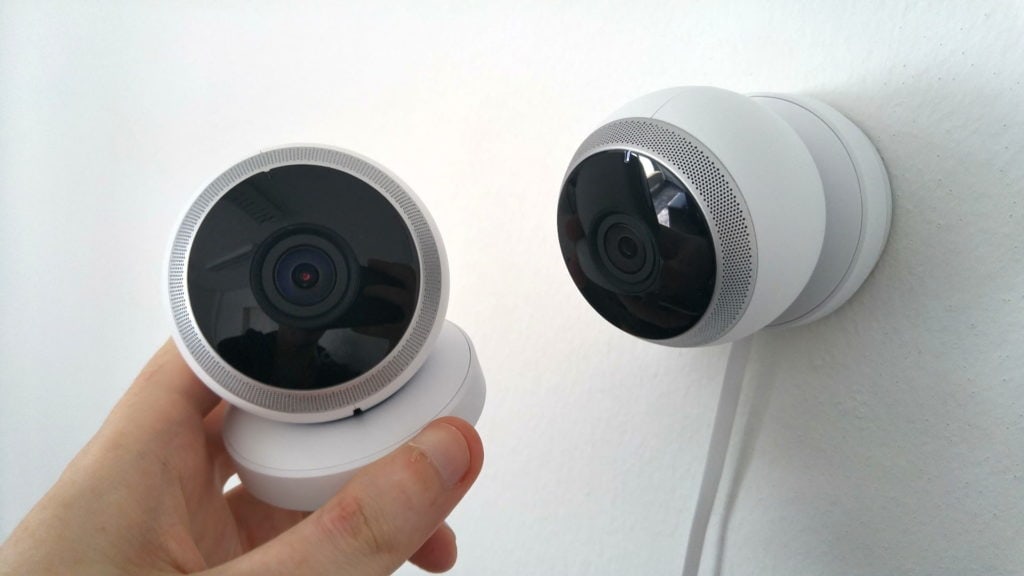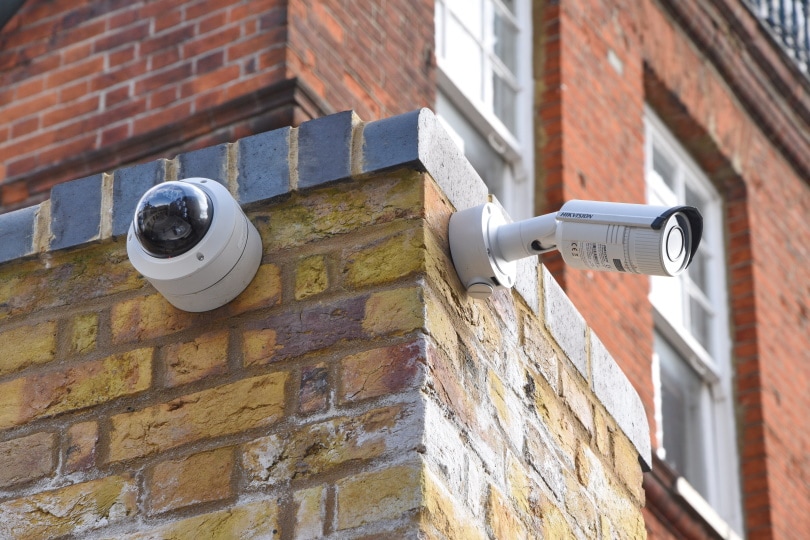How to Spot Fake Security Cameras – 8 Biggest Giveaways
Last Updated on

Differentiating between a genuine surveillance device and a phony enables us to see whether or not an area is truly safe to be in. Many criminals are vigilant, and they frequently look for things that will let them get away with their mischief. This guide will break down everything you need to know about pseudo-cameras and how to spot them.

How to Spot Fake Security Cameras – The 8 Biggest Giveaways
1. They Aren’t Branded

Almost all legitimate security cameras will have a brand name that stands out on the frame of the unit. For example, Ring, Arlo, Reolink, and other brands will have their logo illustrated on their products.
To stay out of copyright and trademark trouble, fake cameras have to erase any markings that would otherwise make them seem real. A lot of times, they will add intimidating jargon such as “CCTV” or “CCD camera” on the sides of the plastic shell to project their legitimacy.
2. Lots of Flashing LED Lights
One huge giveaway when looking at a fake video recorder is an overly conspicuous red light that constantly blinks every few seconds. This is to make it seem like it’s recording when, in reality, it’s just an illusion. Most security cameras do NOT have this indicator light because it draws unnecessary attention. There are a few that do, but they are difficult to see during the daytime, which you should look out for.
3. The Wiring Is a Red Flag
With the rise of sleek, modern security camera models, this giveaway can often be a hard one to get right. Many systems have their cables tucked behind the camera and are fed through a small hole in the wall. This isn’t just for looks, either. It can help prevent wrongdoers from clipping loose wires that dangle too far to ground level.
A lot of times, the fakes will have wires to make it seem like they are powered on and connected. However, some phony product sellers will not include them.
4. Physical Design

By looking at the construction of a camera, you will be much more likely to spot the fakes. If you have looked up fake recorders already, you may have noticed that the majority of them are dome-shaped or bullet-style. Of course, not all of these will be fakes, but one thing that you could see on the dome-style systems is that the real thing will have a swivel mount, where the fakes usually just go up and down.
5. Materials
Fake cameras are made out of cheap materials, like plastic. This is to keep the cost down, and plastic stays somewhat clean when placed outdoors. Aluminum and glass, though, are more premium solutions that will protect the lens and wires against harsher conditions. If it’s raining, the wires need to be sealed correctly so that the electrical system stays intact. Aluminum doesn’t rust and takes more force to be broken.
Sometimes it can be hard to tell what materials are used in the construction process because they are frequently placed in high spots or out of the way.
6. Use an Infrared Detector
Quite a few active cameras share something in common:
They have infrared radiation (IR). This is a wavelength that humans can’t see without special equipment, which is why you might want to use an IR detector. These can be bought at stores or online, and some software developers have created phone apps that can trace this.
If you point the detector or phone sensor towards the camera in question, the signal should show a hidden light that you can’t see in person. Unfortunately, this isn’t always accurate, as some manufacturers make theirs without any infrared radiation.
7. Look at Bluetooth or Wi-Fi Signals

Since wireless security systems have gained popularity in the past decade, their improvements with ease of use and smartphone integration make them a more attractive purchase, especially for consumer-level owners.
If you go to the Bluetooth or Wi-Fi settings of your phone or computer, you may be able to see if any devices show up. You can then search for the number or device ID to see if it aligns with online products. If it does pop up, that very likely means it’s a real camera. If not, you are one step closer to finding the truth.
8. Online Searches
If you are still curious about whether a surveillance system is legitimate or not, a quick Google, Amazon, or Best Buy search will do the trick. Here, you can compare both the actual industry brands and the dummy models with the system that you’re looking at.
A lot of what we mentioned in the previous steps will be present, and you can take your best guess with those factors. Still, many times the fakes will not even have a brand name labeled, so it could take some effort to find the right one.

Conclusion
Fake security cameras are not uncommon, and many businesses or households will resort to them because of their affordable cost and effective crime-deterring abilities. We hope that this educated you on what aspects of surveillance equipment are truly useful and which are just for looks. Stay safe out there!
Featured Image Credit: Alan J. Hendry, Unsplash
About the Author Robert Sparks
Robert’s obsession with all things optical started early in life, when his optician father would bring home prototypes for Robert to play with. Nowadays, Robert is dedicated to helping others find the right optics for their needs. His hobbies include astronomy, astrophysics, and model building. Originally from Newark, NJ, he resides in Santa Fe, New Mexico, where the nighttime skies are filled with glittering stars.
Related Articles:
How to Clean a Rifle Scope: 8 Expert Tips
How to Clean a Refractor Telescope: Step-by-Step Guide
How to Clean a Telescope Eyepiece: Step-by-Step Guide
Monocular vs Telescope: Differences Explained (With Pictures)
What Is a Monocular Used For? 8 Common Functions
How to Clean a Telescope Mirror: 8 Expert Tips
Brightfield vs Phase Contrast Microscopy: The Differences Explained
SkyCamHD Drone Review: Pros, Cons, FAQ, & Verdict
